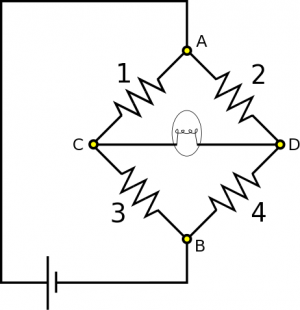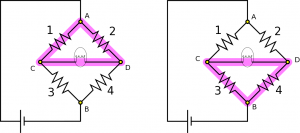This is an old revision of the document!
The Wheatstone Bridge
Suppose you have the following circuit – it is similar to a well known circuit called a Wheatstone bridge. Resistors are labeled 1 through 4 for convenience of reference, and the fifth element is a light bulb, which also has some resistance. If any current at all flows through the light bulb, it will glow. You know $R_1 = 150 \Omega$, $R_2=60 \Omega$, and $R_3$ is variable, meaning you can choose its resistance. Part A: You find that when $R_3=250 \Omega$, the light bulb is off. What is $R_4$? Part B: Suppose we set $R_3=500 \Omega$, so that the light bulb glows. We also have the new information that $\Delta V_{\text{bat}} = 20 \text{ V}$. Which direction does conventional current flow through the light bulb? What is the voltage across the light bulb?
Facts
- $R_1=150 \Omega$
- $R_2=60 \Omega$
- $R_3=250 \Omega$ for Part A, $R_3=500 \Omega$ for Part B.
- $I_{\text{light}}=0$ for Part A.
- $\Delta V_{\text{bat}} = 20\text{ V}$ for Part B.
Lacking
- $R_4$
- Direction of conventional current in light bulb for Part B.
- Potential difference across light bulb for Part B.
Approximations & Assumptions
- The wire has very very small resistance when compared to the other resistors in the circuit.
- The circuit is in a steady state.
- Approximating the battery as a mechanical battery.
- The resistors (including the light bulb) in the circuit are made of Ohmic materials.
Representations
- We represent Ohm's Law as
$$\Delta V = IR$$
- We represent the Loop Rule (for potential difference within a closed loop) as
$$\Delta V_1+\Delta V_2+\Delta V_3+\ldots$$
- We represent the Node Rule (for current through a point in the circuit) as
$$I_{\text{in}} = I_{\text{out}}$$
- We represent the situation with diagram given above.
Solution (Part A)
Since there is no current flowing through the light bulb, we also know there is no voltage across it. We can then apply the Loop Rule to the loops highlighted below to find some equivalent voltages: \begin{align*} \Delta V_1 = \Delta V_2, &&&&& \Delta V_3 = \Delta V_4 \end{align*}
A simple application of Ohm's Law changes these equations into \begin{align*} I_1 R_1 = I_2 R_2 &&&&& (1) \\ I_3 R_3 = I_4 R_4 &&&&& (2) \end{align*} We can refer again to there being no current in the light bulb to say more about the current in the rest of the circuit. Since there is no current in that segment, we can use the Node Rule on Nodes A and B to say $I_1=I_3$ and $I_2=I_4$, respectively. When we plug this into the equation (2), we can find that $$R_4 = \frac{I_1}{I_2}R_3$$ It remains to determine the ratio between the two currents. To do this we simply rearrange equation (1) to express the ratio as being between resistors rather than currents. This gives us a final expression for $R_4$: $$R_4 = \frac{R_2}{R_1}R_3 = 100 \Omega$$
Solution (Part B)
To reiterate the new information, we just found that $R_4=100\Omega$. Now, we change Resistor 3 to $R_3=500\Omega$, and the light bulb glows, so we know current is running through it. We also know $\Delta V_{\text{bat}} = 20 \text{ V}$. We want to find which direction conventional current is directed through the light bulb, and the voltage across the light bulb.
The direction of current shouldn't be terribly hard to figure out. If current is directed to the left, it should then add via the Node Rule to the current directed down through Resistor 3. If current is directed to the right, it should then add via the Node Rule to the current directed down through Resistor 4. Before we changed $R_3$, current was zero. Now, we have increased $R_3$. We can imagine that with the increased resistance, current in Resistor 3 should decrease, so it makes sense for current to directed to the right. One could think of this result both as less current in Resistor 3, or more current in Resistor 4. There are also a lot of other arguments that would reach this same conclusion. For clearness, we have drawn the direction of conventional current in each segment below.
To find $\Delta V_{\text{light}}$, we will need to set up some equations using the Loop Rule and Node Rule. We will focus on Nodes C and D, and the Loops highlighted below.
Applying the Node Rule and the Loop Rule, we obtain the following equations: \begin{align*} I &= I_1 + I_2 &(\text{Node C}) \\ I &= I_3 + I_4 &(\text{Node D}) \\ \Delta V_{\text{bat}} &= \Delta V_1 + \Delta V_3 &(\text{Loop 1}) \\ \Delta V_{\text{bat}} &= \Delta V_2 - \Delta V_{\text{light}} + \Delta V_3 &(\text{Loop 2}) \\ \Delta V_1 + \Delta V_{\text{light}} &= \Delta V_2 &(\text{Loop 3}) \\ \Delta V_{\text{light}} + \Delta V_4 &= \Delta V_3 &(\text{Loop 4}) \end{align*} If we combine the equations from Nodes C and D, and apply Ohm's Law, our resistances come into play, which we know. After applying Ohm's Law, what we have is: $$\frac{\Delta V_1}{R_1} + \frac{\Delta V_2}{R_2} = \frac{\Delta V_3}{R_3} + \frac{\Delta V_4}{R_4}$$ Ultimately, we wish to express $\Delta V_{\text{light}}$ in terms of our known resistances, and $\Delta V_{\text{bat}}$. We need to figure out a way to sub in for the unknowns $\Delta V_1$, $\Delta V_2$, $\Delta V_3$, and $\Delta V_4$ in terms of our known constants. Our approach, which is not the only way to solve this problem, is to express some of our unknowns in terms of $\Delta V_3$, and then try to express $\Delta V_3$ in terms of the the potential differences across the battery and light bulb.
First, we use the equations from Loops 1 and 4 to rewrite our most recent result: $$\frac{\Delta V_{\text{bat}} - \Delta V_3}{R_1} + \frac{\Delta V_2}{R_2} = \frac{\Delta V_3}{R_3} + \frac{\Delta V_3 - \Delta V_{\text{light}}}{R_4}$$ We can also use the result from Loop 2 to sub in for $\Delta V_2$: $$\frac{\Delta V_{\text{bat}} - \Delta V_3}{R_1} + \frac{\Delta V_{\text{bat}} + \Delta V_{\text{light}} - \Delta V_3}{R_2} = \frac{\Delta V_3}{R_3} + \frac{\Delta V_3 - \Delta V_{\text{light}}}{R_4}$$ Now, we must come up with an expression for $\Delta V_3$. This is a little tricky.



